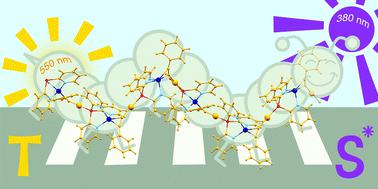当前位置:
X-MOL 学术
›
Dalton Trans.
›
论文详情
Our official English website, www.x-mol.net, welcomes your
feedback! (Note: you will need to create a separate account there.)
Luminescence behaviour of Au(I)-Cu(I) heterobimetallic coordination polymers based on alkynyl-tris(2-pyridyl)phosphine Au(I) complexes.
Dalton Transactions ( IF 3.5 ) Pub Date : 2020-09-02 , DOI: 10.1039/d0dt02583f Stanislav K Petrovskii 1 , Aleksandra V Paderina , Anastasia A Sizova , Andrey Yu Baranov , Alexander A Artem'ev , Vladimir V Sizov , Elena V Grachova
Dalton Transactions ( IF 3.5 ) Pub Date : 2020-09-02 , DOI: 10.1039/d0dt02583f Stanislav K Petrovskii 1 , Aleksandra V Paderina , Anastasia A Sizova , Andrey Yu Baranov , Alexander A Artem'ev , Vladimir V Sizov , Elena V Grachova
Affiliation

|
A set of alkynyl-tris(2-pyridyl)phosphine Au(I) complexes was synthesized and characterized. Free coordination functions on the ligand environment periphery, namely ‘scorpionate’ PPy3 and the C![[triple bond, length as m-dash]](https://www.rsc.org/images/entities/char_e002.gif) C bond, allowed these ditopic metalloligands to be selectively linked to 1D coordination polymers by reaction with Cu(I), which used both Cu–(N-PPy3) and Cu–(η2-C
C bond, allowed these ditopic metalloligands to be selectively linked to 1D coordination polymers by reaction with Cu(I), which used both Cu–(N-PPy3) and Cu–(η2-C![[triple bond, length as m-dash]](https://www.rsc.org/images/entities/char_e002.gif) C) coordination modes. Single-crystal and powder XRD, NMR, and XPS techniques were used to characterize the coordination polymers obtained. Heterobimetallic Au(I)–Cu(I) coordination polymers demonstrate triplet photoluminescence which was studied by spectroscopic and computational methods to understand the pathway of energy transfer inside the chain of linked chromophore centres. The intriguing feature of the electronic structure of heterobimetallic supramolecular assemblies is the ‘long-distance’ electronic transition involving PhC2 and PPy3 ligands located at a distance of more than 1 nm from each other. Thus, the assembly of a heterobimetallic coordination polymer from relatively simple ‘building blocks’ retains the block-wise nature of the electronic structure, but the photophysical properties of the polymer are fundamentally different from the properties of discrete organometallic components.
C) coordination modes. Single-crystal and powder XRD, NMR, and XPS techniques were used to characterize the coordination polymers obtained. Heterobimetallic Au(I)–Cu(I) coordination polymers demonstrate triplet photoluminescence which was studied by spectroscopic and computational methods to understand the pathway of energy transfer inside the chain of linked chromophore centres. The intriguing feature of the electronic structure of heterobimetallic supramolecular assemblies is the ‘long-distance’ electronic transition involving PhC2 and PPy3 ligands located at a distance of more than 1 nm from each other. Thus, the assembly of a heterobimetallic coordination polymer from relatively simple ‘building blocks’ retains the block-wise nature of the electronic structure, but the photophysical properties of the polymer are fundamentally different from the properties of discrete organometallic components.
中文翻译:

基于炔基-三(2-吡啶基)膦Au(I)配合物的Au(I)-Cu(I)异双金属配位聚合物的发光行为。
合成并表征了一组炔基-三(2-吡啶基)膦Au(I)配合物。配体环境外围的自由配位功能,即“蝎形” PPy 3和![[三重键,长度为m-破折号]](https://www.rsc.org/images/entities/char_e002.gif) CC键,使这些二位金属配体通过与Cu(I)反应而选择性连接至一维配位聚合物,Cu(I)均使用Cu–(N -PPy 3)和CU-(η 2 -C
CC键,使这些二位金属配体通过与Cu(I)反应而选择性连接至一维配位聚合物,Cu(I)均使用Cu–(N -PPy 3)和CU-(η 2 -C ![[三重键,长度为m-破折号]](https://www.rsc.org/images/entities/char_e002.gif) C)的配位模式。单晶和粉末XRD,NMR和XPS技术用于表征获得的配位聚合物。异双金属Au(I)–Cu(I)配位聚合物表现出三重态光致发光,已通过光谱和计算方法进行了研究,以了解链接的发色团中心链内部的能量转移途径。异双金属超分子组装体电子结构的一个引人入胜的特征是“长距离”电子跃迁,其中PhC 2和PPy 3配体彼此之间的距离大于1 nm。因此,由相对简单的“结构单元”组装异双金属配位聚合物保留了电子结构的嵌段性质,但聚合物的光物理性质与离散的有机金属组分的性质根本不同。
C)的配位模式。单晶和粉末XRD,NMR和XPS技术用于表征获得的配位聚合物。异双金属Au(I)–Cu(I)配位聚合物表现出三重态光致发光,已通过光谱和计算方法进行了研究,以了解链接的发色团中心链内部的能量转移途径。异双金属超分子组装体电子结构的一个引人入胜的特征是“长距离”电子跃迁,其中PhC 2和PPy 3配体彼此之间的距离大于1 nm。因此,由相对简单的“结构单元”组装异双金属配位聚合物保留了电子结构的嵌段性质,但聚合物的光物理性质与离散的有机金属组分的性质根本不同。
更新日期:2020-10-06
![[triple bond, length as m-dash]](https://www.rsc.org/images/entities/char_e002.gif) C bond, allowed these ditopic metalloligands to be selectively linked to 1D coordination polymers by reaction with Cu(I), which used both Cu–(N-PPy3) and Cu–(η2-C
C bond, allowed these ditopic metalloligands to be selectively linked to 1D coordination polymers by reaction with Cu(I), which used both Cu–(N-PPy3) and Cu–(η2-C![[triple bond, length as m-dash]](https://www.rsc.org/images/entities/char_e002.gif) C) coordination modes. Single-crystal and powder XRD, NMR, and XPS techniques were used to characterize the coordination polymers obtained. Heterobimetallic Au(I)–Cu(I) coordination polymers demonstrate triplet photoluminescence which was studied by spectroscopic and computational methods to understand the pathway of energy transfer inside the chain of linked chromophore centres. The intriguing feature of the electronic structure of heterobimetallic supramolecular assemblies is the ‘long-distance’ electronic transition involving PhC2 and PPy3 ligands located at a distance of more than 1 nm from each other. Thus, the assembly of a heterobimetallic coordination polymer from relatively simple ‘building blocks’ retains the block-wise nature of the electronic structure, but the photophysical properties of the polymer are fundamentally different from the properties of discrete organometallic components.
C) coordination modes. Single-crystal and powder XRD, NMR, and XPS techniques were used to characterize the coordination polymers obtained. Heterobimetallic Au(I)–Cu(I) coordination polymers demonstrate triplet photoluminescence which was studied by spectroscopic and computational methods to understand the pathway of energy transfer inside the chain of linked chromophore centres. The intriguing feature of the electronic structure of heterobimetallic supramolecular assemblies is the ‘long-distance’ electronic transition involving PhC2 and PPy3 ligands located at a distance of more than 1 nm from each other. Thus, the assembly of a heterobimetallic coordination polymer from relatively simple ‘building blocks’ retains the block-wise nature of the electronic structure, but the photophysical properties of the polymer are fundamentally different from the properties of discrete organometallic components.
中文翻译:

基于炔基-三(2-吡啶基)膦Au(I)配合物的Au(I)-Cu(I)异双金属配位聚合物的发光行为。
合成并表征了一组炔基-三(2-吡啶基)膦Au(I)配合物。配体环境外围的自由配位功能,即“蝎形” PPy 3和
![[三重键,长度为m-破折号]](https://www.rsc.org/images/entities/char_e002.gif) CC键,使这些二位金属配体通过与Cu(I)反应而选择性连接至一维配位聚合物,Cu(I)均使用Cu–(N -PPy 3)和CU-(η 2 -C
CC键,使这些二位金属配体通过与Cu(I)反应而选择性连接至一维配位聚合物,Cu(I)均使用Cu–(N -PPy 3)和CU-(η 2 -C ![[三重键,长度为m-破折号]](https://www.rsc.org/images/entities/char_e002.gif) C)的配位模式。单晶和粉末XRD,NMR和XPS技术用于表征获得的配位聚合物。异双金属Au(I)–Cu(I)配位聚合物表现出三重态光致发光,已通过光谱和计算方法进行了研究,以了解链接的发色团中心链内部的能量转移途径。异双金属超分子组装体电子结构的一个引人入胜的特征是“长距离”电子跃迁,其中PhC 2和PPy 3配体彼此之间的距离大于1 nm。因此,由相对简单的“结构单元”组装异双金属配位聚合物保留了电子结构的嵌段性质,但聚合物的光物理性质与离散的有机金属组分的性质根本不同。
C)的配位模式。单晶和粉末XRD,NMR和XPS技术用于表征获得的配位聚合物。异双金属Au(I)–Cu(I)配位聚合物表现出三重态光致发光,已通过光谱和计算方法进行了研究,以了解链接的发色团中心链内部的能量转移途径。异双金属超分子组装体电子结构的一个引人入胜的特征是“长距离”电子跃迁,其中PhC 2和PPy 3配体彼此之间的距离大于1 nm。因此,由相对简单的“结构单元”组装异双金属配位聚合物保留了电子结构的嵌段性质,但聚合物的光物理性质与离散的有机金属组分的性质根本不同。











































 京公网安备 11010802027423号
京公网安备 11010802027423号